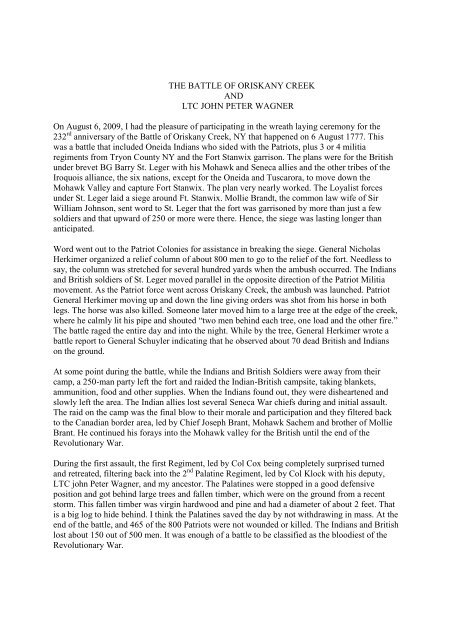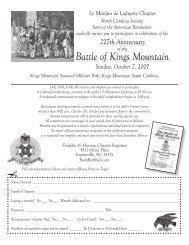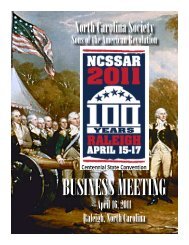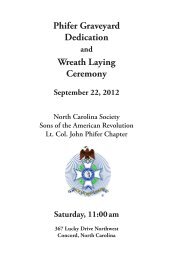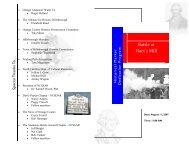THE BATTLE OF ORISKANY CREEK AND LTC JOHN PETER ...
THE BATTLE OF ORISKANY CREEK AND LTC JOHN PETER ...
THE BATTLE OF ORISKANY CREEK AND LTC JOHN PETER ...
You also want an ePaper? Increase the reach of your titles
YUMPU automatically turns print PDFs into web optimized ePapers that Google loves.
<strong>THE</strong> <strong>BATTLE</strong> <strong>OF</strong> <strong>ORISKANY</strong> <strong>CREEK</strong><br />
<strong>AND</strong><br />
<strong>LTC</strong> <strong>JOHN</strong> <strong>PETER</strong> WAGNER<br />
On August 6, 2009, I had the pleasure of participating in the wreath laying ceremony for the<br />
232 rd anniversary of the Battle of Oriskany Creek, NY that happened on 6 August 1777. This<br />
was a battle that included Oneida Indians who sided with the Patriots, plus 3 or 4 militia<br />
regiments from Tryon County NY and the Fort Stanwix garrison. The plans were for the British<br />
under brevet BG Barry St. Leger with his Mohawk and Seneca allies and the other tribes of the<br />
Iroquois alliance, the six nations, except for the Oneida and Tuscarora, to move down the<br />
Mohawk Valley and capture Fort Stanwix. The plan very nearly worked. The Loyalist forces<br />
under St. Leger laid a siege around Ft. Stanwix. Mollie Brandt, the common law wife of Sir<br />
William Johnson, sent word to St. Leger that the fort was garrisoned by more than just a few<br />
soldiers and that upward of 250 or more were there. Hence, the siege was lasting longer than<br />
anticipated.<br />
Word went out to the Patriot Colonies for assistance in breaking the siege. General Nicholas<br />
Herkimer organized a relief column of about 800 men to go to the relief of the fort. Needless to<br />
say, the column was stretched for several hundred yards when the ambush occurred. The Indians<br />
and British soldiers of St. Leger moved parallel in the opposite direction of the Patriot Militia<br />
movement. As the Patriot force went across Oriskany Creek, the ambush was launched. Patriot<br />
General Herkimer moving up and down the line giving orders was shot from his horse in both<br />
legs. The horse was also killed. Someone later moved him to a large tree at the edge of the creek,<br />
where he calmly lit his pipe and shouted “two men behind each tree, one load and the other fire.”<br />
The battle raged the entire day and into the night. While by the tree, General Herkimer wrote a<br />
battle report to General Schuyler indicating that he observed about 70 dead British and Indians<br />
on the ground.<br />
At some point during the battle, while the Indians and British Soldiers were away from their<br />
camp, a 250-man party left the fort and raided the Indian-British campsite, taking blankets,<br />
ammunition, food and other supplies. When the Indians found out, they were disheartened and<br />
slowly left the area. The Indian allies lost several Seneca War chiefs during and initial assault.<br />
The raid on the camp was the final blow to their morale and participation and they filtered back<br />
to the Canadian border area, led by Chief Joseph Brant, Mohawk Sachem and brother of Mollie<br />
Brant. He continued his forays into the Mohawk valley for the British until the end of the<br />
Revolutionary War.<br />
During the first assault, the first Regiment, led by Col Cox being completely surprised turned<br />
and retreated, filtering back into the 2 nd Palatine Regiment, led by Col Klock with his deputy,<br />
<strong>LTC</strong> john Peter Wagner, and my ancestor. The Palatines were stopped in a good defensive<br />
position and got behind large trees and fallen timber, which were on the ground from a recent<br />
storm. This fallen timber was virgin hardwood and pine and had a diameter of about 2 feet. That<br />
is a big log to hide behind. I think the Palatines saved the day by not withdrawing in mass. At the<br />
end of the battle, and 465 of the 800 Patriots were not wounded or killed. The Indians and British<br />
lost about 150 out of 500 men. It was enough of a battle to be classified as the bloodiest of the<br />
Revolutionary War.
So, just who are the Palatines? Well, they were from Germany. The Palatinate (a term not used<br />
in today’s German geography) has a border beginning in the north on the Morsel River about 35<br />
miles SW of Coblenz to Bingen and east to Mainz, down the Rhine River to Oppenheim,<br />
Gutersblum and Worms, then continuing eastward above the Nieckar River about 25 miles east<br />
of Heidelberg, then looping back westerly below Heidelberg to Speyer, south down the Rhine<br />
River to Alsace, then north-westerly back up to its beginning on the Moselle River.<br />
During the Reformation, the Palatinate accepted Protestantism and became the foremost<br />
Calvinist region in Germany. That put them at odds with the ruling parties at that time. After<br />
Martin Luther published his 95 Theses on the door of the castle church at Wittenberg on 31<br />
October 1517, many of his followers came under considerable religious persecution for their<br />
beliefs. Perhaps for the reasons of mutual comfort and support, they gathered in what is known<br />
as the Palatine. These folk came from many places, Germany, Holland, Switzerland and beyond<br />
but all shared a common view on religion.<br />
The Palatinate lay on the western edge of the Holy Roman Empire not far from France’s eastern<br />
boundary. Louis XIV wanted to push his eastern border to the Rhine, the heart of the Palatinate.<br />
Therefore, we have a region filled with followers of Luther, subject to invasion from France,<br />
Britain, and the German Principalities, and Mother Nature’s harshness. The winter of 1708-1709<br />
was particularly harsh, which set the stage for mass migration. At the invitation of Good Queen<br />
Anne in the spring of 1709, about 7,000 harassed Palatines sailed down the Rhine to Rotterdam.<br />
From there about 3000 were dispatched to America. In 1710, three large groups of Palatines<br />
sailed from London. The first went to Ireland, the second to Carolina and the third to New York.<br />
In New York, the Palatines were expected to work for the British authorities producing naval<br />
stores [tar and pitch] for the navy in return for their passage to New York. They were also<br />
expected to act as a buffer between the French and Natives on the northern frontier and the<br />
English Colonies to the south and east.<br />
This is the group of folks we honored on 6 August 2009, the group of Germans who went to the<br />
frontier and settled Tyron, Montgomery and other counties in the Mohawk Valley. The result of<br />
this battle was the successful campaign of Saratoga, which started on 19 September and ended on<br />
October 7, 1777. The American Army surrounded the British army of General John Burgoyne<br />
and he was forced to surrender.<br />
John Peter Wagner, Jr., one of my great-grandfathers, a militia Lieutenant Colonel and a member<br />
of the Tryon County (NY) Militia was a part of that fight. He was born in Stone Arabia 8 Jan<br />
1722 and d. 23 May 1813. He married in Feb 1750 Barbara Dockstader in 1750. She preceded<br />
him in death on 1 Jul 1812. They lived together 62 years. They were parents of seven daughters<br />
and five sons. My descent is from one of the daughters, who later moved with her husband to<br />
Pennsylvania.<br />
General Herkimer's wound was mortal, and he was taken by boat to his home. A very<br />
inexperienced French surgeon amputated his leg, but it was too late to save his life. He called for
his Bible and read to his family and domestics. He died in his home on the banks of the Mohawk<br />
River. His house still stands and is owned by the State of New York and is open to the public.<br />
When the men left Oriskany Creek in August 1777, they thought they had been defeated. Fort<br />
Stanwix was still encircled. What they did not know was that St. Leger would never advance<br />
any further. Gentleman Johnny Burgoyne would be defeated at Saratoga and the plans of the<br />
British would fail. Oriskany Creek led to Saratoga; the victory at Saratoga led to aid from the<br />
French and later the Spanish. Although the Tryon County Militia probably never knew the<br />
importance of the battle of Oriskany Creek, they achieved one of the greatest victories of the<br />
Revolution.<br />
The several Forts that dot the Mohawk Valley are stone-reinforced farmhouses. There is Fort<br />
Frey built in 1739, Fort Klock built in 1750 and Fort Wagner built in 1750. Two of the<br />
structures are still standing, Fort Klock and Fort Wagner. Fort Klock is operated by a private<br />
association and Fort Wagner is in private hands. These “home” forts are where settlers would<br />
gather to defend the area against native attacks.<br />
I close with this. If you want Hollywood’s version of this battle and the Palatines, check out the<br />
movie “Drums Along the Mohawk,” starring Henry Fonda and Claudette Colbert.<br />
David Hill Morrison a direct Descendent of Chief<br />
Joseph Brant and <strong>LTC</strong> Frank Horton, Descendent of<br />
<strong>LTC</strong> John Peter Wagner
The Fort Stanwix National Military Park<br />
Military Detachment<br />
Oneida Living History Contingent from Fort<br />
Stanwix National Military Park<br />
The Leader to the front is the son of the Chief
Chaplain General Clark Wiser giving the Invocation.<br />
Park Superintendent Debbie Conway as at left of<br />
Rev. Wiser<br />
The three of us with CAR, DAR and Descendants
The tree at the upper right is where General Herkimer lay,<br />
After being shot and smoking his pipe and giving orders.<br />
You can barley see the plaque at the tree in the upper right<br />
Of the picture<br />
Joe Robertaccio Explaining Battle Details to Compatriots<br />
Wiser, Powell, Horton and George Gydesen, Oriskany Battle Chapter<br />
President and our host


